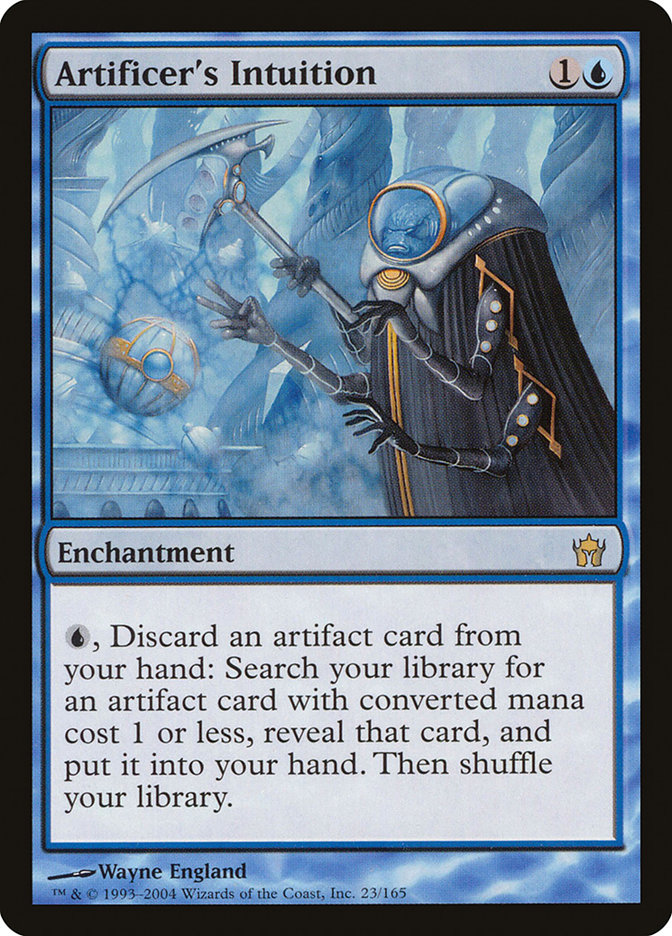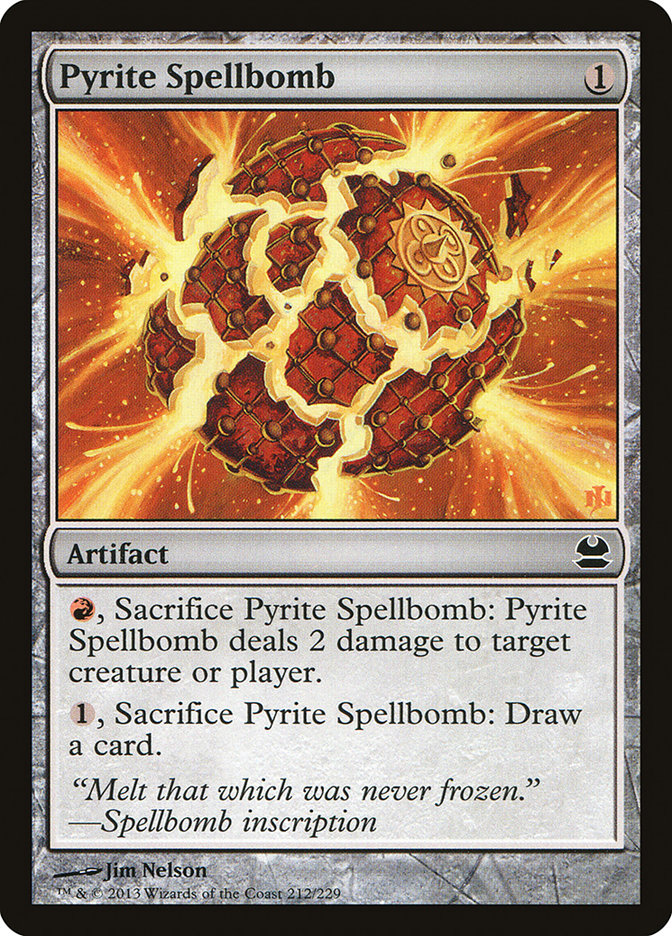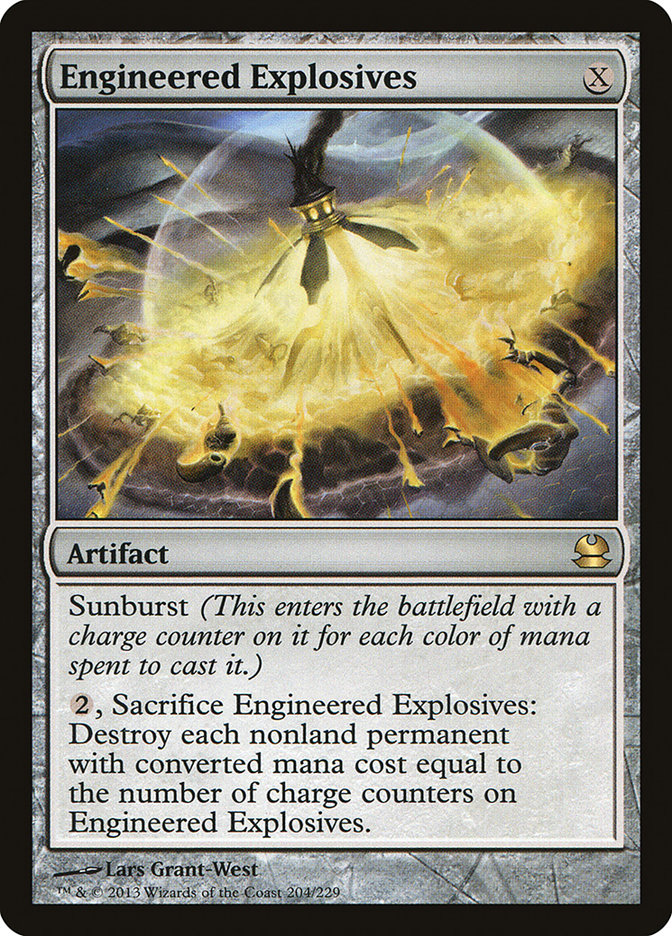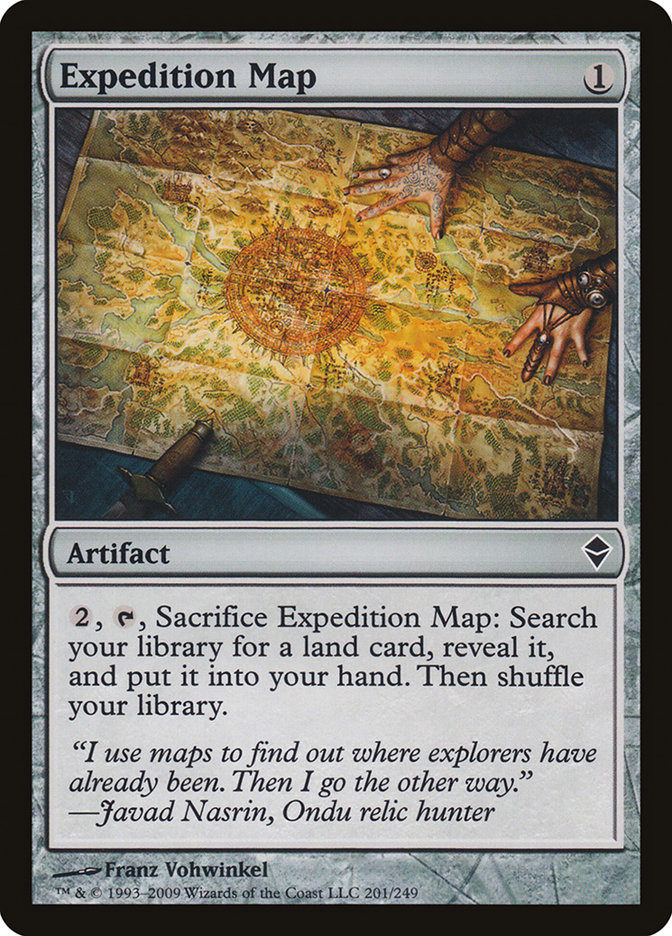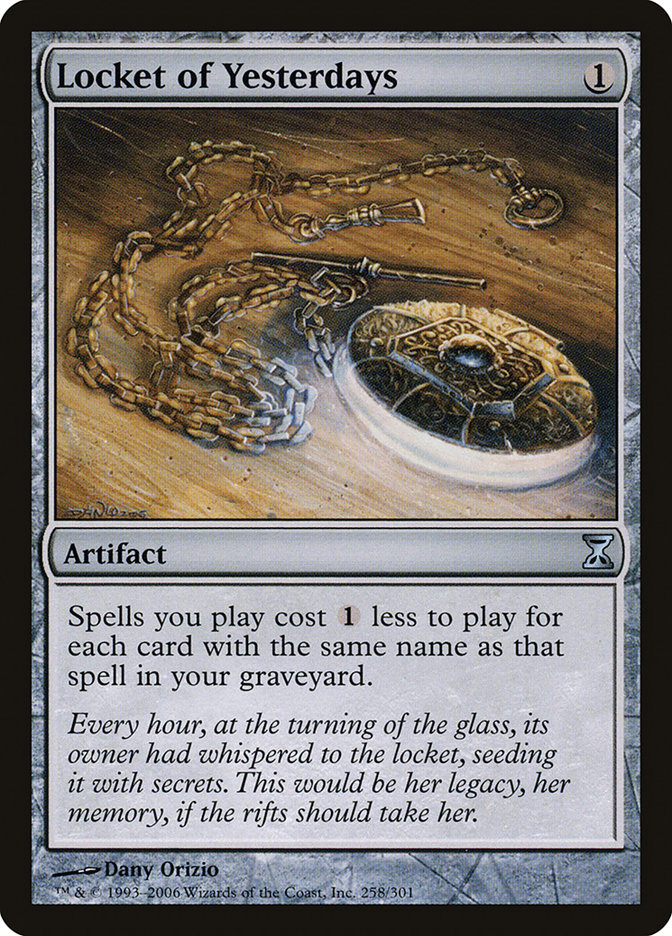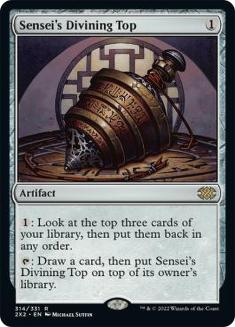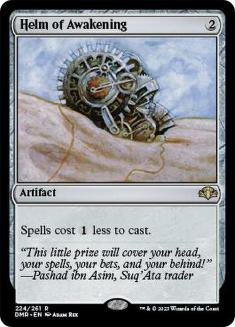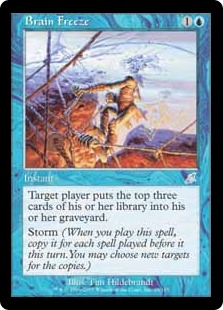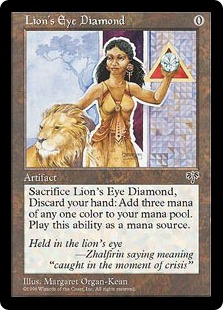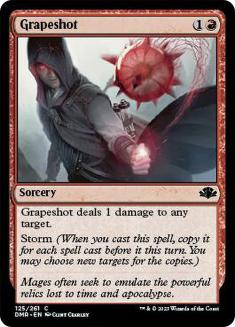Today is Artificer’s Intuition day.
For a long time, people have wondered about how to build decks with, as people have called it "Cog Survival"—a phrase referencing zero- and one-mana artifacts ("cogs") and the Legacy-banned Survival of the Fittest. There are 214 cogs in Magic, although some of them aren’t legal in Legacy. I have spent the last few weeks staring at these tiny artifacts, trying to divine paths to victory using these tiny objects and a card that can sift through them and bury several on each turn.
I started with a very rudimentary Eggs list two weeks ago that wanted to use Artificer’s Intuition to set up a combo turn with Chromatic Star, Chromatic Sphere, Lion’s Eye Diamond, and Second Sunrise. The big takeaway from that adventure seems to be that Zuran Orb and Second Sunrise ought to be best friends. Publishing that (very rough) draft decklist seemed to open the floodgates of community interest in Artificer’s Intuition, though, so today is all about that.
So what does Artificer’s Intuition do really?
It lets you pay a blue mana to discard any artifact—big, small, whatever—to find a tiny artifact and shuffle your deck. Zero- and one-mana artifacts do a lot of stuff, but many of them are either mana producers or weird offbeat Equipment like Spidersilk Net, Slagwurm Armor, and Kite Shield.
There are some quirky build-around cogs like Amulet of Vigor, Aether Vial, and Chalice of the Void, but none of them are great on turn 3. Amulet of Vigor isn’t great in a deck with a ton of artifacts or blue mana, and Chalice of the Void on zero or one locks out a lot of what the deck is trying to do. We’ll pass on this group of cards.
What draws me to Artificer’s Intuition is the ability to find cheap hate cards and powerful artifacts that draw a card and provide some kind of marginal utility outside of their own replacement. Let’s start with those kinds of cards. To get things going, let’s think of how Artificer’s Intuition asks us to build our deck.
We know we’ll be a blue-heavy deck that has a way to shuffle a lot just from the text box of Artificer’s Intuition, so we’d be pretty stupid to pass up on Brainstorm. It’s powerful, is blue, asks us to shuffle our deck, wants us to play cards with varying value over the course of the game—it checks all the boxes.
We can tutor up Sensei’s Divining Top with Artificer’s Intuition and shuffle nearly on command, so it’s not a bad idea to play it. Top replaces itself and draws your best card and then finds your best cog on the next turn, and you can stack the second trigger and Goblin Welder it in and out as a sort of build your own Archivist in the late game.
Since we’re playing a blue deck, it makes sense to play zero-mana artifacts that tap for blue, so let’s start the full set of Seat of the Synod.
So far we’re looking at a pretty boring deck:
4 Artificer’s Intuition
4 Brainstorm
4 Sensei’s Divining Top
4 Seat of the Synod
Let’s spice this up.
What’s the most powerful Legacy-legal cog? Probably one that’s restricted in Vintage, right? No, not Lotus Petal, silly—I’m talking about Lion’s Eye Diamond. We already have twelve cards that interact well with Lion’s Eye Diamond—just put any draw/tutor effect on the stack and respond with Lion’s Eye Diamond to build your own Black Lotus! So what are we going to do with that mana? Casting three one-mana artifacts isn’t exactly blowing anyone’s hair back.
4 Auriok Salvagers
4 Lion’s Eye Diamond
I’m a huge fan of Auriok Salvagers + Lion’s Eye Diamond. If our opponent can’t kill Salvagers, we can make infinite mana of every color. If we have Artificer’s Intuition in play, we can tutor up all of our cogs.
Or we could just activate Pyrite Spellbomb a bunch of times and kill them. And if they have something rude like Pithing Needle or Phyrexian Revoker for our Auriok Salvagers?
We can blow it up with Engineered Explosives. Remember, Lion’s Eye Diamond makes three mana of any one color, so getting to sunburst 1 is trivial and getting to sunburst 2 should be just as easy. If you get to go infinite, you can crank it up to sunburst 4 and blow up their Leyline of Sanctity. Just remember to draw your deck with Pyrite Spellbomb activations first so that you have a followup Auriok Salvagers.
But what if they’re playing a bunch of counterspells? Daze and Force of Will are a big part of why four-drops aren’t totally dominating Legacy—how do we beat those?
Go on. I’ll wait.
.
.
.
.
.
.
The plan is to get a Cavern of Souls or an Academy Ruins with Expedition Map. You then cast Lion’s Eye Diamond, play Cavern of Souls on Human, cast Auriok Salvagers, and go infinite with Spell Pierce backup. It’s easily the worst card in the deck, but I like having a real angle against all of the "wall of BS" Delver decks.
Our deck is shaping up nicely. What does it look like now?
4 Artificer’s Intuition
4 Brainstorm
4 Sensei’s Divining Top
4 Auriok Salvagers
4 Lion’s Eye Diamond
1 Pyrite Spellbomb
1 Engineered Explosives
1 Expedition Map
4 Seat of the Synod
1 Cavern of Souls
1 Academy Ruins
That’s 29 cards, including six lands. We’re still a straight U/W deck, although we may want some red mana for non-combo activations of Pyrite Spellbomb (to kill a Thalia, Guardian of Thraben or something). Let’s take a break from our spells and look at our mana base for a second.
We’re trying to resolve a four-drop in a format that often doesn’t give you a fourth turn. Remember how we talked about a lot of cogs being mana producers? We’re going to want a few of those.
3 Mox Opal
2 Chrome Mox
It’s very possible that we want a sixth Mox. Both Mox Opal and Chrome Mox are excellent in this deck. Chrome Mox is great in a deck that plays many redundant copies of cards with high survivability. What I mean when I say "high survivability" is that the cards are either hard to kill, not worth killing, the first copy tends to win the game on its own, or a combination of all three.
In this case, we have Artificer’s Intuition, Auriok Salvagers, and possibly some planeswalkers that are all great first copies and near worthless second copies. It’s fairly hard to kill a Pillarfield Ox in Legacy since people play mainly Lightning Bolt and Abrupt Decay as removal spells. As for redundancy, the second copy of Artificer’s Intuition is so bad that one of our best case scenarios involves imprinting a redundant copy onto a Chrome Mox. Overall, though, Chrome Mox is a great accelerator for decks with clunky and redundant colored spells, making it a great fit in our deck built around a white four-drop. So what about Mox Opal?
Mox Opal shines in decks with artifact lands, Sensei’s Divining Top, Chrome Mox, and Lion’s Eye Diamond—after all, the point of playing Mox Opal is to enable metalcraft as early as possible. Playing zero- and one-mana artifacts is a great way to enable metalcraft early, so Mox Opal is a good fit. Redundant copies can be pitched to Artificer’s Intuition or used as Lotus Petal per the new legendary permanent rules, so you’ll rarely be sad to see one. I don’t know what the rest of the mana base looks like yet, but a fourth copy isn’t out of the question.
So we’re 33 cards deep, have six lands and five Moxes, and still don’t have a third color. We also don’t have a great way to beat our opponent in a world where they have something as simple as Rest in Peace. Beating down with a literal Pillarfield Ox isn’t exactly exciting—what else can we do?
We have what I believe is a major choice right here. We can play a more hybrid style deck that incorporates Painter’s Servant and tutorable Grindstone, or we can play a more dedicated Auriok Salvagers combo deck with a good stuff shell. Let’s look at the Painter version first:
Creatures (10)
Lands (19)
Spells (31)

This is a pretty streamlined Painter Salvagers hybrid deck. It has Goblin Welder to play a longer game with Sensei’s Divining Top, cuts down on the cutesy Expedition Map and Engineered Explosives toolbox, and plays a combo-centered game. It forces people to fight over every creature that it puts in play; has a ton of ways to accelerate early without getting flooded out late; and has a turn 1 kill of land, Mox Opal, Chrome Mox imprinting anything, Painter’s Servant, Grindstone, Lion’s Eye Diamond, activate everything.
If that sounds too unrealistic, consider that you could also play Goblin Welder on turn 1, pass, cast a Grindstone and Lion’s Eye Diamond on turn 2, activate your artifacts and discard Painter’s Servant, and then Welder Grindstone out and Servant in to kill them with your Grindstone activation on the stack. Older versions of Painter played Lion’s Eye Diamond to kill people with quickness, and while some people have moved over to Blood Moon, LED is still a very real card in Painter decks.
With the step toward Painter’s Servant + Grindstone as a strategy, Mox Opal gets better, and Goblin Welder becomes highly desirable. Once we’re in red and have Painter’s Servant, we probably want a bunch of Red Elemental Blast. Our blue count is too low to support Force of Will, and we can use Painter’s Servant to name blue and turn Red Elemental Blast into a one-mana Vindicate / Counterspell split card. The mana base is a little rough, so if you’re looking for a place to improve, feel free to mess with the numbers there.
The advantages of this build are pretty clear—you aren’t kold to a Pithing Needle on anything, have ways to beat any permanent you can target, and can tutor for half of either of your combos. Lion’s Eye Diamonds is enormously powerful, and you can emphasize or deemphasize either combo after sideboarding. Also, Goblin Welder is obviously just unreal in this deck.
If you saw Painter’s Servant and Grindstone and immediately groaned, don’t worry! You can play a bunch of fiddly blue nonsense and be just fine with this deck:
Creatures (4)
Planeswalkers (7)
Lands (19)
Spells (30)

This deck goes back to the fiddly blue toolbox setup that I was talking about earlier. It has Engineered Explosives to blow up hate permanents, has a miser’s Grafdigger’s Cage to mess with Dredge and Reanimator decks in game 1, has a random Aether Spellbomb in case someone decides to mess around with Show and Tell, has honest to god Force of Will with a blue count of nineteen, and plays seven planeswalkers that can win the game on their own. Make no mistake—this deck is far more vulnerable to Spell Pierce, but it plays a much better midrange game than the first list. It can kill with Salvagers, can kill by turtling up behind a Jace, and can kill out of nowhere by turboing out a Tezzeret and putting nine or ten artifacts in play.
This build leans on the acceleration aspect of the deck pretty hard, and that reliance can create some pretty brutal swings. Sometimes you have four mana on turn 3, and everything’s dandy. Other times you miss your fourth mana source and get jammed with three or more four-drops in your hand. Feel free to adjust the number of planeswalkers down—I wouldn’t blame you.
Whereas the first deck’s philosophy of hate cards is "make them miss and kill them anyway," this deck’s philosophy of hate cards is "all right, cast a planeswalker and control the board—nice Rest in Peace." There are metagames where each strategy is better, but a lot of it can come down to how aggressive you want to be in your game plan. Playing a slower game with planeswalker activations is a conservative plan that will lead to closer games, while playing a deck with two discrete combos in it is an aggressive plan that will lead to games where your opponent is forced to "have it" on an early turn or outright lose. How much you enjoy putting your opponents to the test is up to you.
For those of you who want something even further afield than Auriok Salvagers, we can try our luck with Locket of Yesterdays.
Locket of Yesterdays is basically just a one-sided one-mana Helm of Awakening if you play your cards right. When Sensei’s Divining Top was first printed, everyone and their brother built some version of the following combo deck:
Pretty basic stuff—you bin a Sensei’s Divining Top so that all subsequent Tops cost zero and then flip two Tops back and forth from the battlefield to the top of your library, building a huge storm count that culminates in an eventual Brain Freeze for a million. Locket of Yesterdays is the Helm of Awakening proxy, and Artificer’s Intuition finds every part of the combo except the storm card and bins the Sensei’s Divining Top that you need in the graveyard. A reasonable first cut at the deck would be:
Lands (14)
Spells (46)

The idea here is also pretty straightforward—you have a bunch of deck manipulation to set things up, a good amount of crossover with storm cards, and access to plenty of winning Doomsday piles for various situations. A basic setup involves having an in-play Top, Locket, and Intuition; a cog in hand; and three available mana:
Discard the cog for a Sensei’s Divining Top (two mana left) and discard the Top for Lion’s Eye Diamond (one mana left). Cast LED; activate LED for red (four mana); and spin Top (three mana) to look at Grapeshot, Lion’s Eye Diamond, and Sensei’s Divining Top. Generate infinite storm, spin Top to stack Grapeshot on top, and draw it. Cast it for a million targeting them.
Of course, a million things could be different—your board, your available mana, and so on—but you should be able to find a way to win from most board positions. I invite any and all Doomsday experts to chime in here on ways to improve the core theme, although I do understand that the deck’s Artificer’s Intuition shell is worse than the Duress / Orim’s Chant / Rain of Filth setup that typifies present-day Doomsday decks.
One more for the road, deck idea courtesy of mad genius Greg Hatch:
Creatures (12)
Lands (12)
Spells (36)

So tell me, dear readers, which one of these decks do you like the most?

